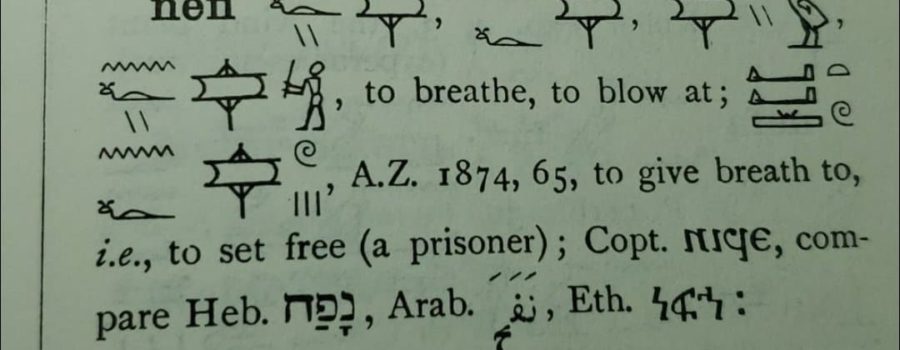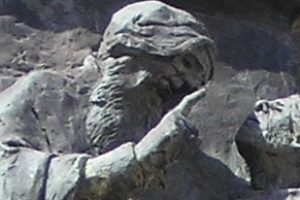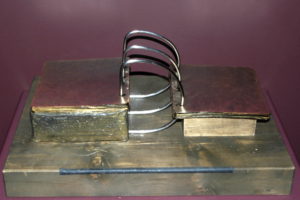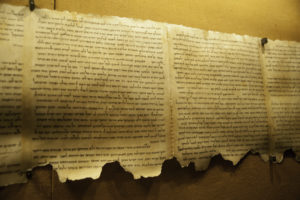Nefi is the originator and first author of The Stick of Joseph in the Hand of Ephraim. This remarkable prophet fled Jerusalem in 601 BCE, just prior to the Babylonian destruction, and began keeping sacred records at God’s command. In this post, we’ll consider more about Nefi, his prophetic role, and the purpose of the record he created, beginning with Nefi’s name.
Nefi was likely named from the ancient Egyptian word nefi which means “to breathe, to blow at; to give breath to, i.e. to set free (a prisoner)… compare Heb. נָפַח” (An Egyptian Hieroglyphic Dictionary; E.A. Wallis Budge; Dover Publications; New York; 1978; Volume 1, page 369, column b). This Egyptian word is actually derived from the Hebrew root Nafach (נָפַח) (Strong’s 5301) having the same meaning “to blow, to breathe.”
The fact that Nefi’s name is an Egyptian form of a Hebrew word comes as no surprise, as he made clear in the very opening of his record:
Yes, I make a record in the language of my father, which consists of the learning of the Y’hudim [Jews] and the language of the Egyptians. (1 Nefi 1:1)
A later author gives further clarification:
And now behold, we have written this record according to our knowledge, in the characters which are called among us reformed Egyptian, being handed down and altered by us according to our manner of speech. And if our plates had been sufficiently large, we should have written in Hebrew; but the Hebrew has been altered by us also. (M’raman 4:11)
This clearly demonstrates the language of the text and those who wrote it was Hebrew, but they used an Egyptian writing system to save space on the plates. Therefore, the idea that Nefi’s name is an Egyptian form of a Hebrew word fits perfectly with the nature of the record Nefi created.
The same word is used in Genesis 2:7, when God breathed (nafach) into Adam’s nostrils the breath of life:
And the LORD God formed man of the dust of the ground, and breathed into his nostrils the breath of life; and man became a living soul.
This is also the root used in Ezekiel 37:9, to prophesy that the spirit, or breath of life (ruach רוח Strong’s 3707), would breathe (nafach נפח Strong’s 5301) on the dry bones of Israel and bring them back to life:
Thus saith the Lord GOD; Come from the four winds, O breath, and breathe upon these slain, that they may live.
This is, of course, the same vision in which Ezekiel prophesied of The Stick of Joseph in the Hand of Ephraim—this very record. It therefore comes as no surprise that a form of Nefi’s actual name appears as the moving action to begin the restoration of Israel. The action that awakens Israel is clearly tied to Nefi’s name, and therefore his record.
Isaiah, likewise, prophesied of Israel’s restoration and future glory. In Isaiah 54, he speaks of Israel’s future redemption and gathering, establishment of righteousness, freedom from fear, and eventual triumph over all her enemies. He even alludes to the future glorious city of Zion and her temple.
In the midst of this beautiful prophecy, we find a curious aside, as follows:
Behold, I have created the smith that bloweth the coals in the fire, and that bringeth forth an instrument for his work (Isaiah 54:16).
This aside, in the midst of promises and prophecies of future glory, seems a bit out of place. There is no readily apparent connection between promised future glory and redemption, and this curious passage about a blacksmith. Or is there?
Examining the underlying Hebrew, we find the word that is translated as “smith” or in other translations, “blacksmith” or “craftsman” is charash (חרש Strong’s 2796), which actually means “engraver, artificer.”
The next word, translated as the verb “blow” or “fan” is nafach (נפח Strong’s 5301)—Nefi’s name, which we’ve looked at above.
These two words alone, when considered in Hebrew, bring tremendous new meaning to Isaiah’s aside, which seems so out of place. Rather than a “blacksmith” who “blows” the coals, we see an underlying allusion to the “engraver, Nefi” who brings forth “an instrument for his work.”
In both Ezekiel’s and Isaiah’s prophecies of the future restoration and gathering of Israel, we find the mention of Nefi—by name—as the operative force by which the work would begin. Nefi is, indeed, the engraver of the instrument by which YHWH’s work has begun again. In fact, Nefi was so integral to the record that throughout a thousand years of Nefite history, the posterity of Nefi and both sets of plates—large and small—bore Nefi’s name.
In closing, we should note one, final, doubly delightful word play. The KJV, and several other translations give charash (engraver) as “smith,” thus equating the “engraver” of the instrument with Yosef ben Yosef, whose English name was Joseph Smith. In the Hebrew, we find Nefi, and in the English, we find Yosef—both named by name, and both vital to the fulfillment of YHWH’s covenants with Israel, set in motion by the record they produced.






Leave a Reply